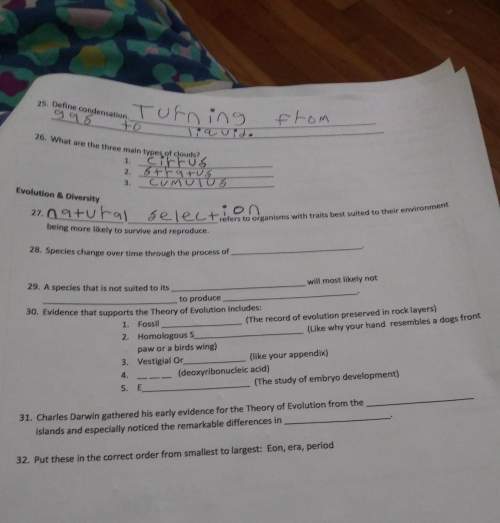
Physics, 12.08.2020 08:01, shawnaelvaughns
The physics of wind instruments is based on the concept of standing waves. When the player blows into the mouthpiece, the column of air inside the instrument vibrates, and standing waves are produced. Although the acoustics of wind instruments is complicated, a simple description in terms of open and closed tubes can help in understanding the physical phenomena related to these instruments. For example, a flute can be described as an open-open pipe because a flutist covers the mouthpiece of the flute only partially. Meanwhile, a clarinet can be described as an open-closed pipe because the mouthpiece of the clarinet is almost completely closed by the reed.
1. Consider a pipe of length 80.0 cm open at both ends. What is the lowest frequency f of the sound wave produced when you blow into the pipe?
2. A hole is now drilled through the side of the pipe and air is blown again into the pipe through the same opening. The fundamental frequency of the sound wave generated in the pipe is now:.
a. the same as before.
b. lower than before.
c. higher than before.
3. If you take the original pipe in Part A and drill a hole at a position half the length of the pipe, what is the fundamental frequency of the sound that can be produced in the pipe?
4. What frequencies, in terms of the fundamental frequency of the original pipe in Part A, can you create when blowing air into the pipe that has a hole halfway down its length?
4-1. Recall from the discussion in Part B that the standing wave produced in the pipe must have an antinode near the hole. Thus only the harmonics that have an antinode halfway down the pipe will still be present.
A. Only the odd multiples of the fundamental frequency.
B. Only the even multiples of the fundamental frequency.
C. All integer multiples of the fundamental frequency.
E. What length of open-closed pipe would you need to achieve the same fundamental frequency as the open pipe discussed in Part A?
A. Half the length of the open-open pipe.
B. Twice the length of the open-open pipe.
C. One-fourth the length of the open-open pipe.
D. Four times the length of the open-open pipe.
E. The same as the length of the open-open pipe.
F. What is the frequency of the first possible harmonic after the fundamental frequency in the open-closed pipe described in Part E?
F-1. Recall that possible frequencies of standing waves that can be generated in an open-closed pipe include only odd harmonics. Then the first possible harmonic after the fundamental frequency is the third
harmonic.

Answers: 1
Other questions on the subject: Physics

Physics, 22.06.2019 02:40, SMURFETTE86
15. one purpose of the tread pattern on a tire is to a reduce tire wear. b. reduce traction c. allow water to flow away from the tire. d. look impressive.
Answers: 1

Physics, 22.06.2019 16:20, Kkgiddy
Iupil u5l aluve time remaining 01: 53: 45 ei and both agreed that childhood experiences play an important role in the development of oneself a sigmund freud alfred adler b. carl jung alfred adler c. carl jung erik erikson d. sigmund freud.. carl jung select the best answer from the choices provided save and exit next submit mark this and return
Answers: 1


Physics, 22.06.2019 18:30, ptrlvn01
Two 2.0-cm-diameter disks face each other, 1.0 mm apart. they are charged to ±10 nc. what is the electric field strength between the disks? a proton is shot from the negative disk toward the positive disk. what launch speed must the proton have to just barely reach the positive disk?
Answers: 1
Do you know the correct answer?
The physics of wind instruments is based on the concept of standing waves. When the player blows int...
Questions in other subjects:

History, 03.03.2020 14:18

Geography, 03.03.2020 14:22

History, 03.03.2020 14:37

Social Studies, 03.03.2020 14:50

English, 03.03.2020 14:50


English, 03.03.2020 14:51



Mathematics, 03.03.2020 14:51







